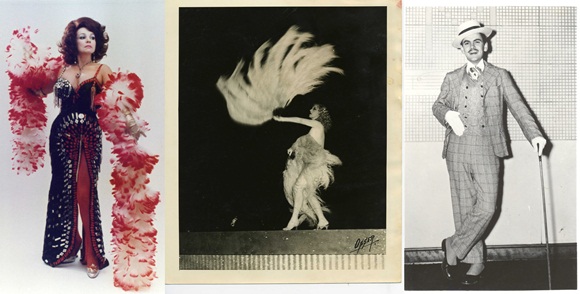The Daily Bump and Grind: The Real World Behind the Burly Q
By Rose Nagle-Yndigoyen

Images c/o the Leslie Zemekis collection
The word burlesque conjures up all sorts of bawdy images: strippers swinging tassels and brandishing feathered fans, wafts of tarnished air smelling of sequins and seediness. It's a cheeky art form. Modern performers like Christina Aguilera borrow a little of that old-time salaciousness to give their audience a thrill. But the real world of burlesque was more than just tassle-deep in the American psyche. This type of entertainment was a massive industry. It was also a far reaching one, touching every corner of society, from gangsters to presidents, from families to women of all types.
In Behind the Burly Q, Leslie Zemekis has collected the stories, memorabilia, photographs and recollections of an entire generation of performers from the heyday of burlesque, and manages to restart the heart of that wild world. The expected bawdy, bubbly, zany stories are there, but very real stories of struggle, heartbreak and danger come in equal measure.
Behind the Burly Q began as a documentary, and the intensive interviews and research for the film are put to full use in the boo, amounting to a thorough oral history of burlesque, liberally garnished with never-before collected photographs. The result is not a dense read, not in the slightest. In fact, any page you open to has an astonishing tale to draw the reader in. It might be the story of the talented Sally Keith, who could twirl four tassels at one time -- “one on each bra cup and one on each butt cheek” -- while singing and dancing. Or the literally wild exploits of burlesque performers who worked animals into their stripper acts, including birds, monkeys, snakes, horses and even bears. Or the glamorous star-studded roster of male admirers that attended the best women in burlesque, the respectable likes of Gary Cooper, Frank Sinatra and JFK.
But of course, the burlesque industry wasn't all glamorous beasts and powerful men. The women Zemekis interviewed for the book are candid about the reasons they got into "peeling": to escape abusive parents or husbands, to avoid living on the streets, or for the practical reason of supporting their families. "At sixteen, I had three children, and I was supporting those children," a performer named Joni Taylor says. Zemekis uses the recollections of performers, producers and fans to paint a clear picture of the socioeconomic reality of burlesque in the 1920s, 30s and 40s. Was there a stigma to it? "No," says Betty Rowland aka "Ball of Fire," "because everyone was working in it." Seen from one angle, the burlesque circuit was simply an opportunity for women with little or no education to earn decent money and to gain status and community.
Seen from the audience’s perspective, burlesque was also an escape from the dreary realities of economic depression and war. Behind the Burly Q recounts performances that involved musicians, comedians and other family-friendly entertainment, in addition to the pretty women in flimsy, if glamorous outfits. Zemekis traces the industry from that incarnation to the much darker, more explicitly sexual performances of the 1960s. The evolution of vice laws, American society’s changing relationship to sexuality in general and other social movements all factor into that progression. The constant interplay between popular performances like burlesque and Americans’ internal sexual psychology is clear. Satisfyingly, Zemekis traces the path all the way through to the current-day burlesque influence on modern pop stars like Katy Perry, RuPaul and Lady Gaga.
The special work of memoirs and biographies is that they can transport you to a real place in time. The conversations real people had, the pictures they took, and the stories they've carried for years all spring back into life. This is exactly what Behind the Burly Q does -- the faded image of a bygone era is fanned back into full color. The end result? A book that ropes you into a world more fraught -- and more fabulous -- than your average fantasy.
